Abstract
Wave phase difference is a fundamental property that characterises the relative behaviour of transmitted signals. It has significant roles in signal wave analysis and in interpreting various propagation phenomena, which are crucial when designing wireless links and various applications in signal processing techniques, optics, and acoustics. This study investigated the concept of phase difference significance based on high frequencies (i.e., 1.0, 2.4, 10.0, and 20.0 GHz). Several phase difference models and their shortcomings were reviewed to emphasise the need for greater accuracy and precision in quantifying phase differences. The outcomes revealed that 1 GHz contributed to the lowest phase difference among the other frequencies. A constructive signal may be deployed to provide a better link build-up. Overall, determining the importance of phase difference in GHz and identifying the signal attitude substantially contribute to the advancement of wave analysis, while simultaneously encouraging further exploration in this domain.
1. Introduction
Phase difference refers to the variation between the phase angles of two waves, which can occur when the signal hits the surface and is reflected, depending on its properties. Signal reflections on the conducting lines generally display a phase shift from the incident signal. Short circuits (closed line) and open circuits (broken line) are extreme examples of termination, in which a change can occur in the reflected wave in both circumstances. The amplitude, wavelength, or phase of the reflection at the surface of the separation of two media may change. However, a change in amplitude or wavelength can illustrate a clear difference between incident and reflected light [1].
The phase difference between waves has a crucial role in interference, diffraction, and wave interactions. It affects the resulting wave patterns, amplitudes, and constructive or destructive interference impacts. Measuring and controlling the phase difference between waves is important in various applications, such as telecommunications, signal processing, optics, and acoustics.
The numeric value of the phase is determined by the subjective choice of the start of each period and the angle interval, which can be influenced by wavelength when frequency is applied. When there is no difference between the phases, the two signals are in phase with each other; otherwise, they are out of phase [2].
When two signals are placed together, they form a constructive interference that increases the signal amplitude and the entire wave, such as that observed in a microphone device that works under the constructive phase phenomenal. However, two waves that cancel each other lead to zero wave; known as destructive interference [3]. In some transmission techniques, including microwave transmission technology, the phase shift device can control the radio frequency signal in phased arrays to steer the signal in various directions without moving the antenna.
One study on the effect of reflector curvature on signal amplitude and phase changes for reflected and transmitted waves between general anisotropic media revealed via comparison between numerical and analytical outcomes that using the plane-wave reflection coefficient without correction for the interface effect could lead to inaccurate interpretations of AVA/AVO analyses (note: AVO refers to amplitude-versus-offset and AVA represents amplitude-versus-angle) [4].
Many scholars have explored phase differences in various aspects. For instance, the principle of phase difference mask resulted in destructive interference and attained better image contrast [5]. In another study, a minor phase difference was measured in a fibre interferometer for pressure sensing [6]. Next, a study on electron–proton deuteron scattering examined the intermediate energies reported in [7] and found that the near-similar sets significantly differed from the initial values and this enhanced the reliability of the final parameter values.
Overall, the phase of a wave is determined by several factors, including the frequency, wavelength, and starting point of the wave. The phase difference between two waves denotes the angular difference between their respective phases at a given point in time or space. It quantifies how much a wave has shifted or delayed relative to the other. As such, this study examined the impact of GHz wavelength on the predictive phase difference, which is substantially significant to wireless engineers when designing links.
The rest of this paper is as follows: Section two explains the model approach and the equations. Section three presents the results. The final section concludes this study.
2. The Model Approach
Physical surfaces are assumed to be rough, while roughness influences the dispersion of electromagnetic waves. The degree of roughness of a scattering surface cannot be considered a fundamental characteristic of that surface; instead, it is determined by the properties of the transmitted wave. The frequency of the transmitted wave and the angle of incidence both affect the roughness or the smoothness of a surface look. Ks refers to the relationship between electromagnetic wavelength and statistical roughness parameters, with k = 2π/λ. The local incidence angle is crucial when assessing surface roughness, especially in the near field where the propagation is rougher than in the far field. Fresnel reflection may be defined as an ideal smooth surface that serves as a function of the transmitted and reflected angles, as well as the scattering dielectric constant. The Fresnel reflection coefficient is expressed as follows: [8]
where is a plane wave Fresnel reflection coefficient for vertical and horizontal, denotes the grazing angle on the reflecting surface, and are relative permittivity and electrical conductivity, respectively, of the reflecting surface, indicates vertical polarisation, and signifies horizontal polarisation transmission.
This study examined the interaction of the transmitted EM wave with surfaces of different roughness levels based on phase angle, which can change in accordance with wavelengths. Diffuse surfaces are more likely to cause directional scattering than smooth ones. From the electromagnetic standpoint, categorising a surface as smooth or rough is entirely subjective.
Both the Rayleigh and Fraunhofer criteria that specify a smooth surface are elaborated in [9]. The phase difference between two rays distributed from distinct points on the surface of an angle-transmitted plane homogenous wave is illustrated as follows:
Referring to Figure 1, the sine and cosine waves demonstrate the differences in surface waves that reflect the signal behaviour in terms of amplitude and angle. Mathematically, Maxwell’s equations are the best way to deal with the wave equation [10]:
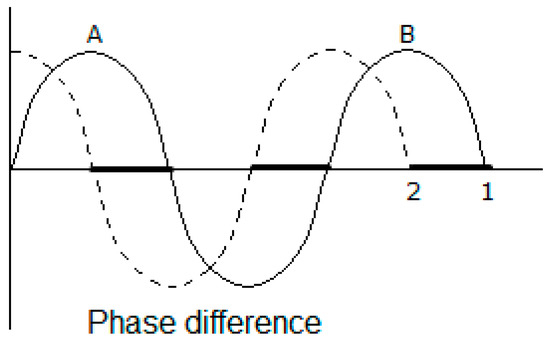
Figure 1.
Illustration of the phase difference terminology.
Assuming that the propagation is in the X direction, then .
Hence,
Upon placing time consideration,
Commonly used in the engineering domain, Equation (5) represents wave propagation that is applicable to analyse various wave phenomena, including interference, propagation, and diffraction, which enables the modelling of wave behaviour in varying contexts. Here, Ey(x, t) represents the electric field component in the y-direction as a function of position (x) and time (t).
A and B refer to complex constants that determine the amplitude and phase of the wave; and are complex exponential functions that describe the spatial and temporal behaviour of the wave; indicates the angular frequency related to frequency (f) according to = 2πf; and denotes the wave number related to wavelength (λ) according to = 2π/λ.
The phase shift can be determined by taking the derivative of Equation (5) in light of , while treating , , , and as constants. This results in the following:
Referring to Equation (6), the two parts represent the incident and reflected waves, where the phase shift is attainable through the reflected part by considering = . While the standard deviation σ describes variability, the amplitude A represents magnitude. They are both relevant aspects of each other and to the wave, besides being equal to η. Since the phase difference is concerned with the phase component, the following equation is obtained after applying some trigonometry for simplification of use:
which is
The calculates the difference between the cos and the sin of angle , and multiplying it by generates the overall phase difference that would quantify the phase difference in terms of the provided parameters.
The model proposed in this study was examined based on a set of high frequencies (1 to 20 GHz) to determine the impact of wavelength on the phase.
Figure 1 shows the phase shift displacement in wavelength refers to the change in the position of a wave, particularly in terms of its crest and trough.
3. Results and Discussion
This study assessed 1.0, 2.4, 10.0, and 20.0 GHz (equivalent to 0.29, 0.12, 0.02, and 0.01 wavelengths in metres, respectively) to distinguish the comprehensive phase shift notion that offers significant outcomes by using Matlab simulation software. The results retrieved for each wavelength were combined to determine the impact. The following figures elucidate the concept.
Figure 2 illustrates the phase difference at 1 GHz, which is starts from 40 and slope down to −60 at angle 2.5 degree and then raise up to hit 60 at angle 5.5 degree.
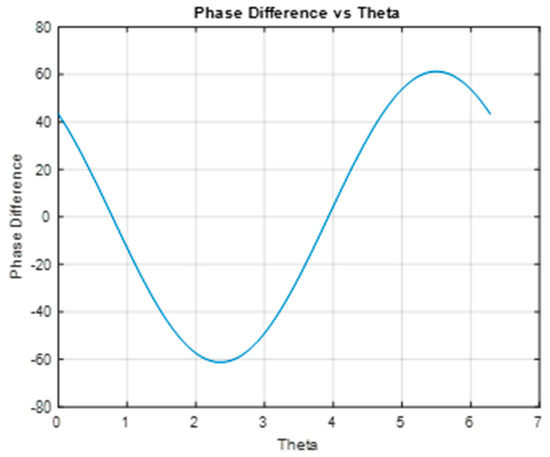
Figure 2.
Phase difference at 1.0 GHz.
Figure 3 shows the phase difference at 2.4 GHz, which is starts from 100 and slope down to −150 at angle 2.5 degree and then raise up to hit 150 at angle 5.5 degree.
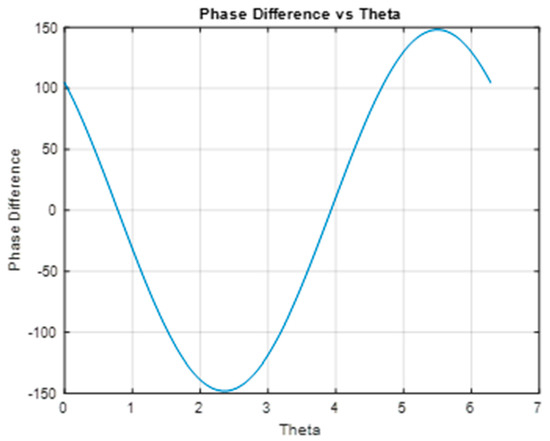
Figure 3.
Phase difference at 2.4 GHz.
Figure 4 illustrates the phase difference at 10 GHz, which is starts from 600 and slope down to −900 at angle 2.5 degree and then raise up to hit 900 at angle 5.5 degree.
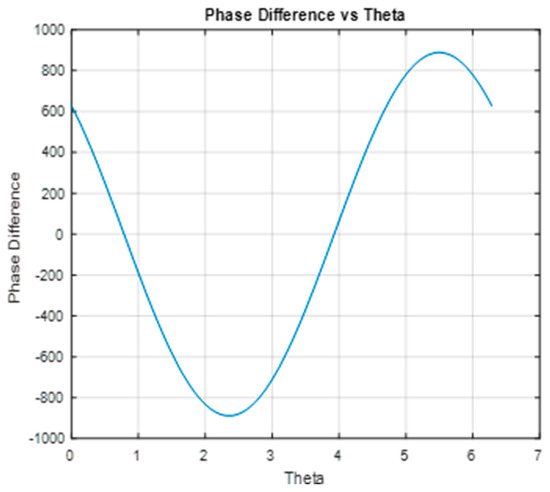
Figure 4.
Phase difference at 10.0 GHz.
Figure 5 demonstrates the phase difference at 20 GHz, which is starts from 1250 and slope down to −1750 at angle 2.5 degree and then raise up to hit 1750 at angle 5.5 degree.

Figure 5.
Phase difference at 20.0 GHz.
Figure 6 illustrates the phase difference up to 20 GHz, using wavelength 0.01 in blue, 0.02 in red, 0.12 in yellow, and 0.29 in purple respectively to ensure the relation with different frequencies.
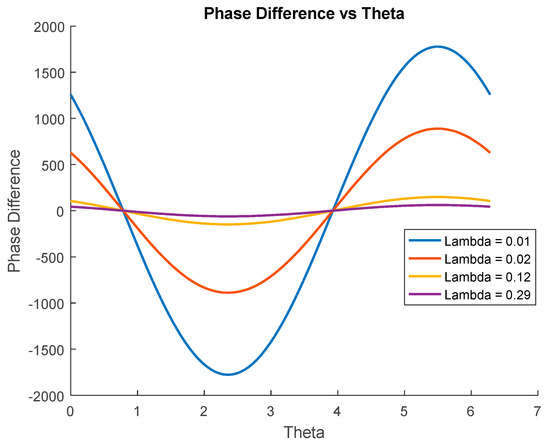
Figure 6.
Phase difference at GHz frequency up to 20 GHz.
Since varying wavelengths lead to different phase differences, careful attention should be given while constructing the wireless link to accept such events favourably. As explained earlier, the simulation successfully adapted to the constructive interface after several considerations.
4. Conclusions
The phase difference in GHz is significant due to the technological revolution that suggests occurrences at high frequencies. This study addressed the phase when dealing with a set of GHz frequencies (i.e., 1.0, 2.4, 10.0, and 20.0 GHz, equivalent to 0.29, 0.12, 0.02, and 0.01 wavelengths in metres, respectively). The findings revealed that 1 GHz (0.29 m wavelength) recorded the lowest phase shift, signifying that lower frequencies dealt better than higher frequencies in terms of phase difference. The construction interference should be handled in that band to allow for profound advantages when designing wireless links, whereas otherwise it takes place when destructive interference is observed between the waves. Future research endeavours may look into the combination of wave phase difference with intelligent surfaces.
Author Contributions
Conceptualization, I.E.E. and I.I.M.; methodology, I.I.M.; software, I.E.E.; validation, I.E.E., I.I.M. and M.S.A.K.; formal analysis, I.E.E.; investigation, I.E.E.; resources, I.E.E.; data curation, I.E.E.; writing—original draft preparation, I.E.E. and M.S.A.K. All authors have read and agreed to the published version of the manuscript.
Funding
This research received no external funding.
Institutional Review Board Statement
The study has undergone ethical review and approval.
Informed Consent Statement
I have read and understand the information in this publication.
Data Availability Statement
Data are contained within the article.
Acknowledgments
University Malaysia Pahang, Malaysia.
Conflicts of Interest
The authors declare no conflict of interest.
References
- Edser, E.; Stansfield, H. Phase-Change of light on Reflection at a Silver Surface. Nature 1897, 56, 504–506. [Google Scholar] [CrossRef]
- Slepyan, L. Phase shift in forced oscillations and waves. Eur. J. Mech.-A/Solids 2022, 96, 104762. [Google Scholar] [CrossRef]
- Cano, J.M.; Mojumdar, M.R.R.; Norniella, J.G.; Orcajo, G.A. Phase shifting transformer model for direct approach power flow studies. Int. J. Electr. Power Energy Syst. 2017, 91, 71–79. [Google Scholar] [CrossRef]
- Ursin, B.; Favretto-Cristini, N.; Cristini, P. Amplitude and phase changes for reflected and transmitted waves from a curved interface in anisotropic media. Geophys. J. Int. 2021, 224, 719–737. [Google Scholar] [CrossRef]
- Romeo, C.; Cantù, P. Lithography Masks and Pattern Transfer. In Encyclopedia of Condensed Matter Physics; Bassani, F., Liedl, G.L., Wyder, P., Eds.; Elsevier: Amsterdam, The Netherlands, 2005; pp. 136–145. ISBN 9780123694010. [Google Scholar] [CrossRef]
- Hariharan, P. Chapter 13—Interferometric Sensors. In Basics of Interferometry; Hariharan, P., Ed.; Academic Press: Cambridge, MA, USA, 2005; pp. 129–138. ISBN 9780080918617. [Google Scholar] [CrossRef]
- Smits, J.W.; Kok, L.P.; Malfliet, R.A. Phase Shift Analysis Of Elastic Proton-Deuteron Scattering At Intermediate Energies And Possible Excited States in 3He. In Few Particle Problems; Slaus, I., Moszkowski, S.A., Haddock, R.P., van Oers, W.T.H., Eds.; Elsevier: Amsterdam, The Netherlands, 1972; pp. 547–550. ISBN 9780444104397. [Google Scholar] [CrossRef]
- El-Sallabi, H.; Albadr, A.; Aldosari, A. UAV propagation channel characteristics in SHF band. In Proceedings of the SPIE 11021, Unmanned Systems Technology XXI, 110210H, Baltimore, MD, USA, 13 May 2019. [Google Scholar]
- Schröder, S.; Duparré, A.; Coriand, L.; Tünnermann, A.; Penalver, D.H.; Harvey, J.E. Modeling of light scattering in different regimes of surface roughness. Opt. Express 2011, 19, 9820–9835. [Google Scholar] [CrossRef] [PubMed]
- Mitolo, M.; Araneo, R. A Brief History of Maxwell’s Equations [History]. IEEE Ind. Appl. Mag. 2019, 25, 8–13. [Google Scholar] [CrossRef]
Disclaimer/Publisher’s Note: The statements, opinions and data contained in all publications are solely those of the individual author(s) and contributor(s) and not of MDPI and/or the editor(s). MDPI and/or the editor(s) disclaim responsibility for any injury to people or property resulting from any ideas, methods, instructions or products referred to in the content. |
© 2023 by the authors. Licensee MDPI, Basel, Switzerland. This article is an open access article distributed under the terms and conditions of the Creative Commons Attribution (CC BY) license (https://creativecommons.org/licenses/by/4.0/).